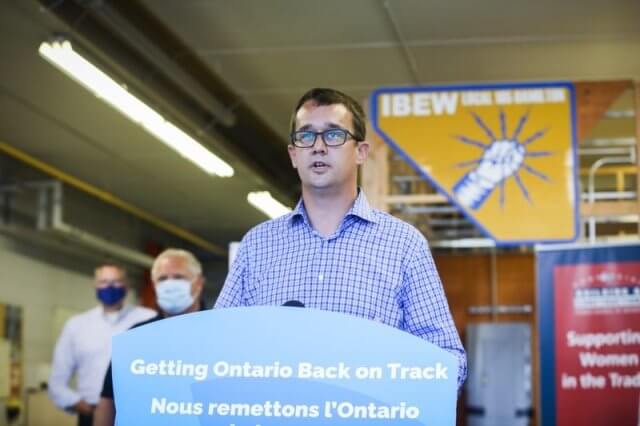Ontario Ramping Up Protection for Long-Term Care Residents
Robust action plan and new emergency order to protect the most vulnerable in long-term care homes
The Voice of Canada News:O
TORONTO — In order to better protect the most vulnerable and stop the spread of COVID-19 in long-term care homes, the Ontario government has developed a robust action plan with key measures to be implemented within hours. In addition, the province has issued a new emergency order restricting long-term care staff from working in more than one long-term care home, retirement home or health care setting. These measures are being taken on the advice of Ontario’s Chief Medical Officer of Health.
The COVID-19 Action Plan: Long-Term Care Homes was announced by Premier Doug Ford, Christine Elliott, Deputy Premier and Minister of Health, and Dr. Merrilee Fullerton, Minister of Long-Term Care.
“We will do everything we can to protect our seniors and most vulnerable citizens because we all know they are most at risk during this pandemic,” said Premier Ford. “Our three-point action plan builds on the measures we have already taken to fortify that iron ring of protection we have placed around our long-term care residents and those who care for them.”
The COVID-19 Action Plan: Long-Term Care Homes adds critical new measures to prevent further outbreaks and deaths from COVID-19 in long-term care homes, including:
- Aggressive Testing, Screening, and Surveillance: enhancing testing for symptomatic residents and staff and those who have been in contact with persons confirmed to have COVID-19; expanding screening to include more asymptomatic contacts of confirmed cases; and leveraging surveillance tools to enable care providers to move proactively against the disease.
- Managing Outbreaks and Spread of the Disease: supporting long-term care homes with public health and infection control expertise to contain and prevent outbreaks; providing additional training and support for current staff working in outbreak conditions.
- Growing our Heroic Long-Term Care Workforce: redeploying staff from hospitals and home and community care to support the long-term care home workforce and respond to outbreaks, alongside intensive on-going recruitment initiatives.
Additional measures under development will help to ensure preparedness and respond to the situation as it evolves, including improving isolation capacity at long-term care homes.
Within less than 48 hours, the government will immediately act to deliver:
- enhanced testing and surveillance for symptomatic residents and staff and those in contact with persons confirmed to have COVID-19;
- testing of asymptomatic residents and staff in select homes across the province to better understand how COVID-19 is spreading;
- risk and capacity assessments for all homes;
- working with Ontario Health, the Ontario Hospital Association, and public health units to assemble infection control and preventions teams and additional supports;
- enhanced guidance on personal protective equipment and continued priority distribution to homes;
- enhanced training and education to support staff working in outbreak situations; and
- redeploying hospital and home care resources into homes.
“We must continue to act to stop the spread of this virus in our long-term care homes,” said Dr. Merrilee Fullerton, Minister of Long-Term Care. “Nothing is more important than protecting the health and well-being of our loved ones in long-term care, or the front-line heroes who care for them.”
“This new action plan significantly enhances existing efforts to stop the spread of COVID-19 and protect our most vulnerable, including long-term care home residents and the staff who care for them,” said Christine Elliott, Deputy Premier and Minister of Health. “Having significantly expanded the scope and scale of testing and made considerable progress in securing personal protective equipment, Ontario has never been better positioned to deliver on our commitment to support long-term care homes in our shared battle against this virus.”
The government has also issued an emergency order directing long-term care employers to ensure their employees, including registered nurses, registered practical nurses, personal support workers, kitchen and cleaning staff only work in one long-term care home. This means that employees cannot work in multiple locations such as a retirement home or other health care setting.
As a result of this order, long-term care workers who must temporarily give up a job in another care setting are protected from losing their job as they are entitled to an unpaid leave of absence. To help long-term care workers make up these lost wages, the government encourages long-term care employers to offer full-time hours to their part-time employees during the COVID-19 outbreak.
To help employers cover this expense, the government is taking action to ensure long-term care homes have the flexibility and funds to rapidly hire nurses and other front-line staff they need, when they need them. These emergency funds are available to help long-term care homes cover the incremental costs of increasing hours for part-time staff to help those staff limit their work locations.
All long-term care staff continue to be subject to rigorous screening procedures and must follow personal protective equipment guidelines, including wearing surgical masks, gowns, gloves and eye protection while in homes.
Quick Facts
- The COVID-19 Action Plan: Long-Term Care Homes will continue to evolve in response to COVID-19. The government is actively seeking and acting on proposals to fight this virus through the Ontario Together portal.
- The temporary emergency order will come into effect on April 22, 2020 in order to give long-term care homes enough time to be compliant with the order. It builds on previous emergency orders issued March 24 and March 28, 2020.
- An investment of $243 million in COVID-19 emergency funding is available to homes to cover the costs associated with securing the staffing, supplies, and capacity they need at this unprecedented time.
- To help understaffed long-term care homes find qualified staff, the government launched an online tool to help match skilled front-line workers with employers: the Health Workforce Matching Portal.




